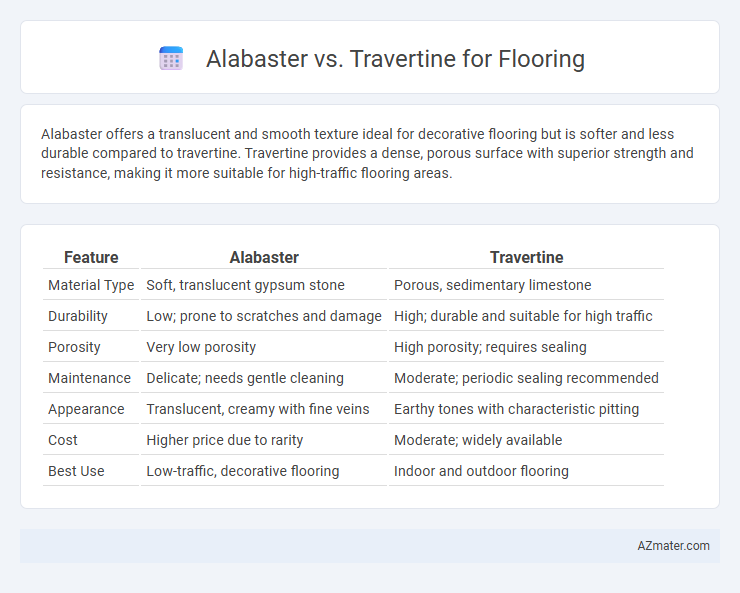Alabaster offers a translucent and smooth texture ideal for decorative flooring but is softer and less durable compared to travertine. Travertine provides a dense, porous surface with superior strength and resistance, making it more suitable for high-traffic flooring areas.
Table of Comparison
| Feature | Alabaster | Travertine |
|---|---|---|
| Material Type | Soft, translucent gypsum stone | Porous, sedimentary limestone |
| Durability | Low; prone to scratches and damage | High; durable and suitable for high traffic |
| Porosity | Very low porosity | High porosity; requires sealing |
| Maintenance | Delicate; needs gentle cleaning | Moderate; periodic sealing recommended |
| Appearance | Translucent, creamy with fine veins | Earthy tones with characteristic pitting |
| Cost | Higher price due to rarity | Moderate; widely available |
| Best Use | Low-traffic, decorative flooring | Indoor and outdoor flooring |
Introduction to Alabaster and Travertine Flooring
Alabaster flooring offers a smooth, translucent surface prized for its soft, elegant appearance and ability to diffuse light, making spaces feel airy and luminous. Travertine flooring, characterized by its natural porous texture and warm earth tones, provides durable, slip-resistant surfaces ideal for both indoor and outdoor applications. When choosing between alabaster and travertine, considerations include alabaster's delicate nature and travertine's robust, weather-resistant properties.
Key Differences Between Alabaster and Travertine
Alabaster is a softer, translucent stone primarily composed of gypsum or calcite, offering a smooth, refined appearance ideal for indoor flooring with low foot traffic. Travertine is a durable, porous limestone characterized by natural pits and a textured surface, making it suitable for high-traffic areas and outdoor use due to its slip resistance. The key differences lie in hardness, opacity, durability, and maintenance, with alabaster requiring careful sealing and handling, while travertine demands routine sealing to prevent staining and erosion.
Appearance and Aesthetic Appeal
Alabaster flooring boasts a smooth, translucent quality with soft, milky tones that create an elegant, luminous ambiance, ideal for luxurious interiors. Travertine offers a more rustic, textured appearance with natural pits and varied earthy colors, lending a warm, timeless charm to spaces. Both materials enhance aesthetic appeal but cater to distinct design styles--Alabaster for modern sophistication and Travertine for classic, natural beauty.
Durability and Hardness Comparison
Alabaster, a softer and more delicate stone with a Mohs hardness of around 2, is less durable compared to travertine, which typically rates between 5 and 6 on the Mohs scale, making it more suitable for high-traffic flooring areas. Travertine's dense, porous structure provides greater resistance to wear and impact, whereas alabaster's softness makes it prone to scratches and damage under heavy foot traffic. For flooring, travertine offers superior hardness and durability, ensuring longevity and minimal maintenance in residential or commercial spaces.
Maintenance and Cleaning Requirements
Alabaster flooring requires gentle cleaning with a pH-neutral cleaner to prevent damage, as it is a soft, porous stone prone to scratching and staining. Travertine flooring demands regular sealing to protect against moisture and stains, with maintenance involving sweeping and mopping using mild detergents to preserve its natural texture. Both materials benefit from prompt spill cleanup to maintain their appearance and extend flooring longevity.
Cost and Value Considerations
Alabaster flooring typically commands a higher price than travertine due to its rarity and unique translucent qualities, making it a premium choice for luxury interiors. Travertine offers a more cost-effective option with versatile color variations and durability suitable for high-traffic areas, providing strong long-term value. When considering return on investment, alabaster enhances property aesthetics significantly, while travertine balances upfront cost with reliable performance and easier maintenance.
Installation Process and Challenges
Alabaster flooring requires careful installation due to its softness and susceptibility to scratching, often needing a more delicate adhesive and gentle cutting tools to avoid damage. Travertine, being a denser natural stone, offers greater durability during installation but demands precise sealing and grout application to prevent staining and moisture penetration. Both materials present challenges in leveling and substrate preparation, with alabaster's fragility and travertine's porosity necessitating specialized expertise for optimal results.
Environmental Impact and Sustainability
Alabaster and travertine differ significantly in their environmental impact and sustainability for flooring applications. Alabaster, a softer form of gypsum, often requires less energy-intensive processing but is less durable, leading to more frequent replacement and higher long-term resource use. Travertine, a natural limestone formed through mineral deposits from hot springs, offers greater durability and longevity, reducing environmental costs over time despite its higher initial quarrying impact.
Best Applications: Home and Commercial Spaces
Alabaster flooring excels in residential spaces due to its translucent quality and soft, warm tones that enhance natural light and create a cozy atmosphere. Travertine is better suited for commercial environments, offering exceptional durability, slip resistance, and a variety of textured finishes ideal for high-traffic areas and outdoor applications. Both materials provide timeless elegance, but selecting alabaster for intimate settings and travertine for robust, high-use floors maximizes aesthetic appeal and longevity.
Which is Better: Alabaster or Travertine for Flooring?
Alabaster offers a softer, more translucent appearance ideal for decorative flooring with a luxurious finish, while travertine provides superior durability and slip resistance, making it a practical choice for high-traffic areas. Travertine's natural porosity requires sealing to prevent staining, unlike alabaster, which demands careful maintenance due to its softer composition and susceptibility to scratches. For flooring that balances aesthetics and long-lasting performance, travertine is generally the better option, especially in homes with heavy foot traffic or moisture exposure.

Infographic: Alabaster vs Travertine for Flooring
 azmater.com
azmater.com